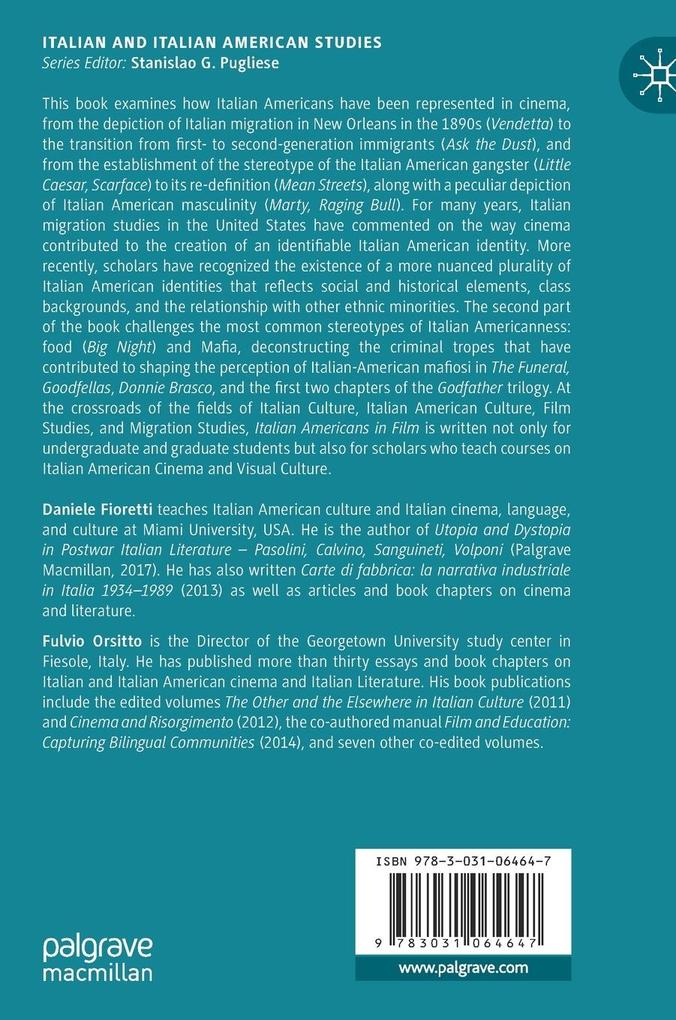
Zustellung: Sa, 28.06. - Mi, 02.07.
Versand in 1-2 Wochen
VersandkostenfreiBestellen & in Filiale abholen:
This book examines how Italian Americans have been represented in cinema, from the depiction of Italian migration in New Orleans in the 1890s (Vendetta) to the transition from first- to second-generation immigrants (Ask the Dust), and from the establishment of the stereotype of the Italian American gangster (Little Caesar, Scarface) to its re-definition (Mean Streets), along with a peculiar depiction of Italian American masculinity (Marty, Raging Bull). For many years, Italian migration studies in the United States have commented on the way cinema contributed to the creation of an identifiable Italian American identity. More recently, scholars have recognized the existence of a more nuanced plurality of Italian American identities that reflects social and historical elements, class backgrounds, and the relationship with other ethnic minorities. The second part of the book challenges the most common stereotypes of Italian Americanness: food (BigNight) and Mafia, deconstructing the criminal tropes that have contributed to shaping the perception of Italian-American mafiosi in The Funeral, Goodfellas, Donnie Brasco, and the first two chapters of the Godfather trilogy. At the crossroads of the fields of Italian Culture, Italian American Culture, Film Studies, and Migration Studies, Italian Americans in Film is written not only for undergraduate and graduate students but also for scholars who teach courses on Italian American Cinema and Visual Culture.
Inhaltsverzeichnis
1. Introduction. - 2. `I Don t Do Business with Dagoes : Anti-Italian Discrimination in Nicholas Meyer s Vendetta. - 3. Ask the `Dust Jacket . Robert Towne s Film Adaptation of John Fante s Ask the Dust. - 4. Setting the Italian American Gangster in Stone: Little Caesar and Scarface. - 5. Nice Guys Finish Last? Delbert Mann s Marty. - 6. The Italian American Prizefighter: Ethnicity in Martin Scorsese s Raging Bull. - 7. Mean Streets. A Mirror Construction of Reality. - 8. The Funeral: Taking Aim at the Stereotype. - 9. Good Food is Close to God: Religious Overtones of the Culinary Arts in Big Night. - 10. The Eclipse of the Godfather s Garden: From the Agromafia to the Money Mafia. - 11. Goodfellas. When the `Kid from Little Italy Meets the `Oklahoma Kid . - 12. Mike Newell s Donnie Brasco between Classic Hollywood and the New Gangster. - 13. Documentary andItalian American Identity: Time and Exposure in Alfred Guzzetti s Family Films.
Produktdetails
Erscheinungsdatum
01. Dezember 2022
Sprache
englisch
Auflage
1st edition 2023
Seitenanzahl
312
Reihe
Italian and Italian American Studies
Herausgegeben von
Daniele Fioretti, Fulvio Orsitto
Verlag/Hersteller
Produktart
gebunden
Abbildungen
XXVI, 283 p. 41 illus., 33 illus. in color.
Gewicht
518 g
Größe (L/B/H)
216/153/22 mm
ISBN
9783031064647
Entdecken Sie mehr
Pressestimmen
Indeed, Italian American cinema has in many ways held an outsized space in academic studies of Italian American cultural production. The student of Italian American cinema will also find helpful the extensive bibliography that concludes each essay, as well as the additional section of films cited, which can help the reader move beyond the works that are the focus of the chapters and widen their familiarity with cinematic texts that have yet to become part of the canon. (Rebecca Bauman, Italian American Review, Vol. 14 (2), 2024)
Bewertungen
0 Bewertungen
Es wurden noch keine Bewertungen abgegeben. Schreiben Sie die erste Bewertung zu "Italian Americans in Film" und helfen Sie damit anderen bei der Kaufentscheidung.









